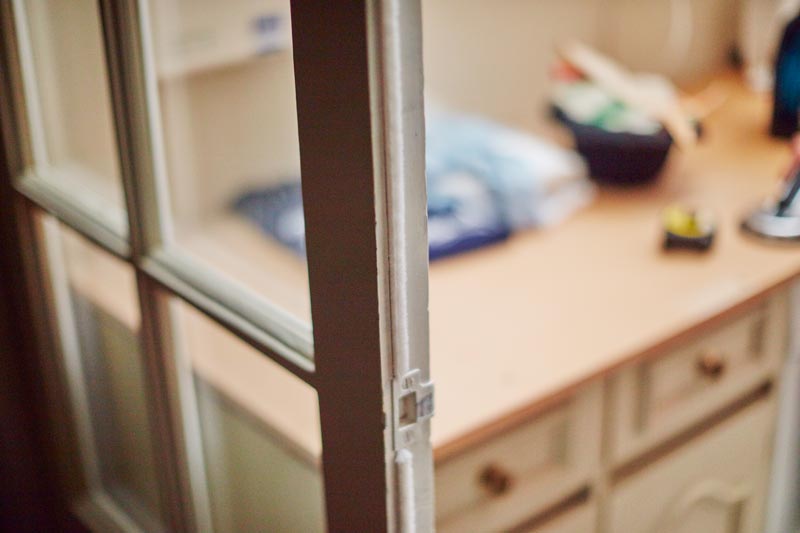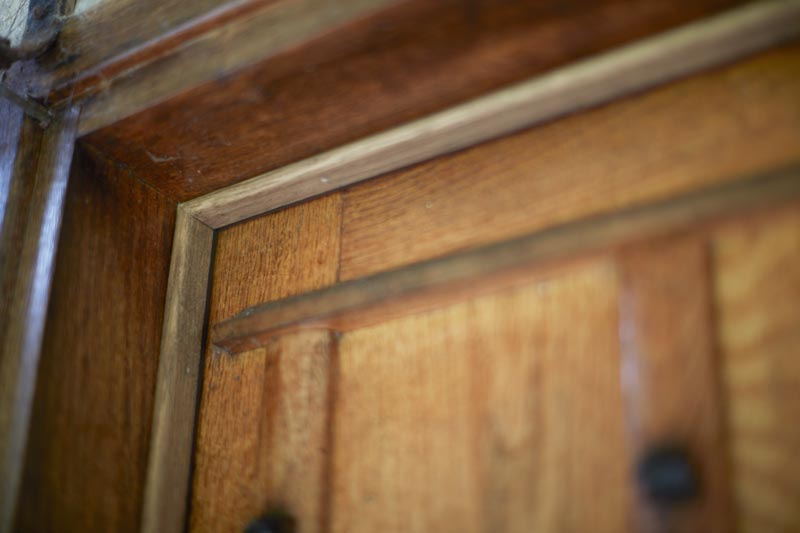There’s nothing worse than feeling a chilly draught stealing across your sitting room while you are relaxing at home in winter. Fortunately, Mitchell & Dickinson offers perfect draught proofing solutions.
Draughts are the biggest source of heat loss in many period homes and cause a large increase in heating costs. When you add up how much you’ve spent heating your home over a year, it’s a small fortune.
The solutions available on the building market don’t usually look very good (for example, visible plastic brushes) and if DIY-fitted, don’t always work well. They can make it hard to close doors and windows and often come off after a few years.

Elegant, durable draught seals
We’ve developed a comprehensive range of elegant, durable draught seals that work beautifully, stand the test of time and are concealed. This allows you to control the loss of heat and draughts during cold weather while providing enough ventilation to allow the building to breathe.
We aim to cut draughts by 70% so that there is still adequate background ventilation, minimising condensation and keeping your home from becoming damp.
Our range of specialised draught proofing uses durable rubber window and door seals fitted into elegant timber beading, routed-in door brushes and concealed-brush beading for sash windows. It looks attractive, unobtrusive and, most importantly, does the job.
If you’re interested in finding out more, we’re happy to talk you through your options.
Drop our friendly customer services team a call or use the enquiry form below.

Draught proofing solutions for period properties
Mitchell & Dickinson provides draught proofing solutions to owners of period homes and listed properties across the south of England. Our craftsmen will work with you to make your home warmer in keeping with the age and style of your property.
We have operational teams across the South, South West and the Midlands, including London, Bath, Cornwall, Devon, Dorset, Somerset, Bristol, Gloucestershire, Monmouthshire, Worcestershire, Warwickshire, the West Midlands, Oxfordshire, Northamptonshire, Buckinghamshire, Wiltshire, Hampshire, Berkshire, Surrey and Sussex.
If you’re interested in finding out more, we’re happy to talk you through your options.
Drop our friendly customer services team a call or use the enquiry form below.
Your draught proofing questions answered
Draught proofing is a process that involves sealing gaps and openings around and in windows and doors to prevent cold air from entering and warm air from escaping. This is achieved by fitting draught strips and other products to improve thermal performance. This helps create a more comfortable and energy-efficient internal environment.
The draughtiness of a building is determined by the amount of air that can pass through the external fabric – walls, roof, floor, windows and doors. This is called air permeability. Most listed and period buildings are permeable, ie they were not designed to be completely sealed from the external environment. However, the important factor is not the permeability itself but the rate at which air passes through the building.
If your home is well draught proofed this exchange and movement of air is reduced. Common signs that your home may benefit from draught proofing include noticeable drafts from doors and windows or other small gaps in the fabric, high energy bills, and difficulty maintaining a consistent and comfortable temperature when the heating is on. Our experts at Mitchell & Dickinson can assess your property to determine the most effective draught proofing solutions.
Different products and levels of expertise will achieve varying levels of effectiveness. Mitchell & Dickinson use durable and long-lasting materials suited to the fabric of your home, and apply our superior craftsmanship to fit them. We estimate that our full draught proofing service will reduce draughts by approximately 70% in a typical period building. We don’t aim for a 100% reduction as traditional buildings need a certain amount of background ventilation so they can ‘breathe’, meaning that moisture does not get trapped.
Draughts (or air infiltration) are often one of the biggest sources of heat loss in a building. In a typical ‘unimproved’ period building (one that has not had modern insulation measures applied) we estimate the draughts cause approximately 30% of total heat loss. To accurately measure the sources and rate of draughtiness (or air infiltration) an air pressure test is required.
However, most occupants know where the draughts come from and where they are worst because they can feel it! Windows, doors and chimneys will normally be responsible for the majority of the draughts. Mitchell & Dickinson’s surveyors will help you identify the draught sources and their contribution to your building’s thermal performance.
Yes, draught proofing is a versatile solution that can be applied to various types of windows and doors, including sash windows, casement windows and timber doors. Mitchell & Dickinson offers tailored draught proofing options to suit different architectural styles and materials. Leaded windows and stone mullions present particular challenges but in most cases we can reduce draughts using our Cosy Glazing secondary glazing system.
The cost of draught proofing depends on factors such as the size of your property, the number of windows and doors, and the extent of draught proofing required. Remember investing in energy efficiency measures should save you money in the long term as you won’t have to use as much energy to keep your home warm. For a personalised quote, please contact Mitchell & Dickinson for a consultation.
Absolutely. Draught proofing is a valuable solution for older or historic properties, helping to enhance comfort without compromising the integrity of original features. Mitchell & Dickinson specializes in providing draught proofing solutions that respect the character of heritage buildings.
While some draught proofing products especially DIY products are applied to surfaces of windows and doors, Mitchell & Dickinson’s draught proofing solutions are designed to be discreet and preserve the aesthetic appeal of your windows and doors. Our range uses durable rubber window and door seals fitted into elegant timber beading, routed-in door brushes and concealed-brush beading for sash windows. It looks attractive, unobtrusive and, most importantly, does the job. Our Our goal is to enhance energy efficiency without compromising the visual charm of your property.
Yes, draught proofing can contribute to noise reduction by improving the fit of of windows and doors against their frames, and closing up gaps. While it may not eliminate all noise, it can significantly improve your home’s acoustic insulation. Secondary glazing can help too.
The installation time for draught proofing varies depending on the size of the project and the number of windows and doors being treated. Our experienced teams works efficiently to minimse disruption, and we’ll provide a timeframe during the consultation process.
While some DIY draught proofing solutions exist, professional installation ensures optimal results. Mitchell & Dickinson’s team has the expertise to assess your specific needs and provide a tailored draught proofing solution that addresses your home’s unique requirements.
Yes, draught proofing is a key element in improving energy efficiency by minimising heat loss and reducing the need for constant heating. This can lead to lower energy bills and a more sustainable home.







